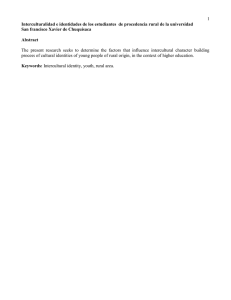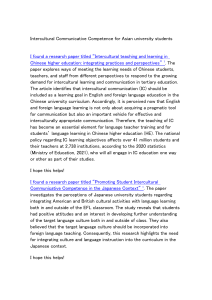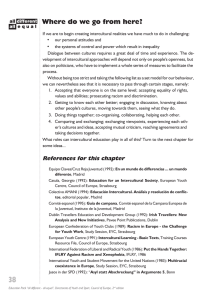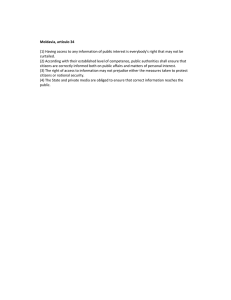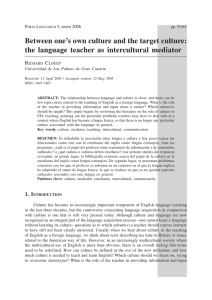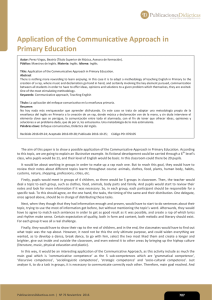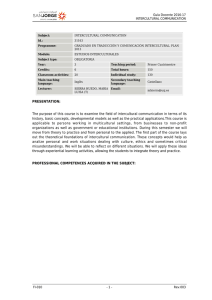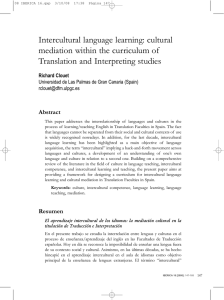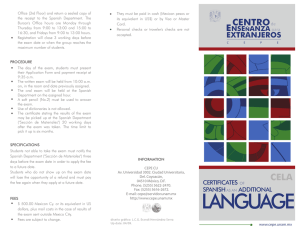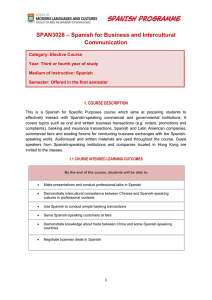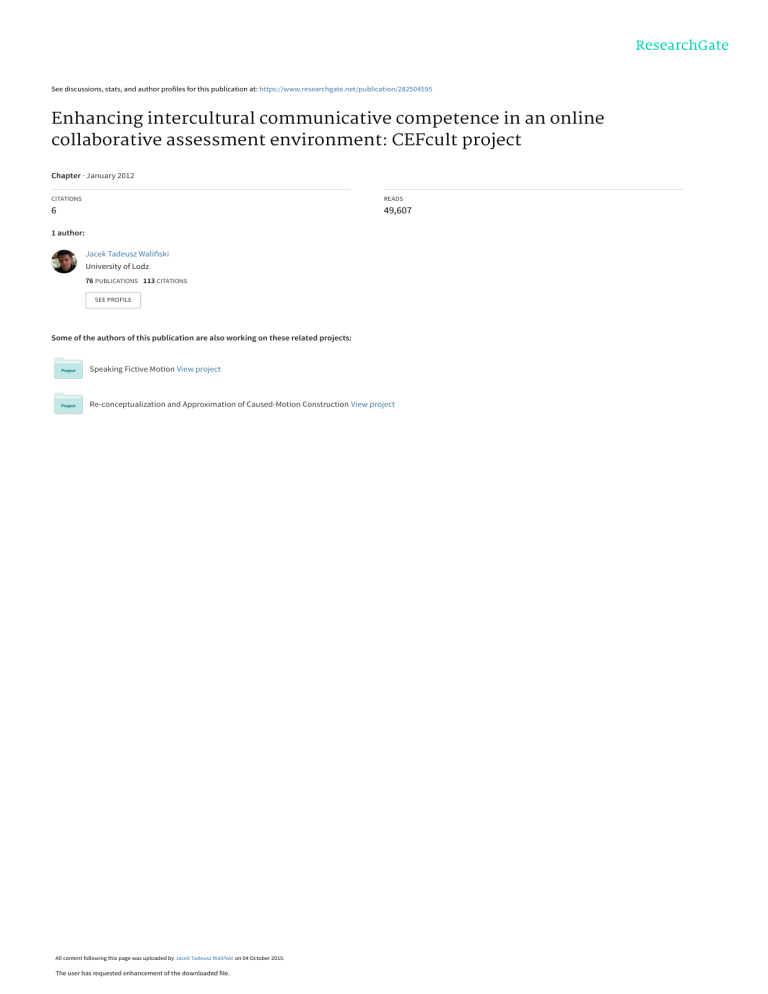
See discussions, stats, and author profiles for this publication at: https://www.researchgate.net/publication/282504595 Enhancing intercultural communicative competence in an online collaborative assessment environment: CEFcult project Chapter · January 2012 CITATIONS READS 6 49,607 1 author: Jacek Tadeusz Waliński University of Lodz 76 PUBLICATIONS 113 CITATIONS SEE PROFILE Some of the authors of this publication are also working on these related projects: Speaking Fictive Motion View project Re-conceptualization and Approximation of Caused-Motion Construction View project All content following this page was uploaded by Jacek Tadeusz Waliński on 04 October 2015. The user has requested enhancement of the downloaded file. Enhancing intercultural communicative competence in an online collaborative assessment environment: CEFcult project Jacek Tadeusz Waliński Abstract: The CEFcult Project provides an online environment that enables self-, peer- and expert evaluation of spoken language proficiency and intercultural communicative competence in professional communication. By combining the CEFR scales for language proficiency with the INCA rating scales for intercultural competence the project has translated the concepts of linguistic competence and intercultural competence into a single assessment framework (based on Byram’s model of Intercultural Communicative Competence) that is applicable in practice through the use of operationalized scales. The project has developed a flexible collaborative assessment platform to measure and raise intercultural communicative competence through implementation of real-life scenarios based on spoken interaction typical of the modern international enterprise. Educators and professionals in intercultural communication and collaboration can contribute to the CEFcult environment with new custom scenarios and further expansion of the assessment framework. Keywords: CEFcult, intercultural competence, intercultural communicative competence, assessment, oral proficiency, learning platform, CEFR, INCA, WebCEF 1. Introduction Facing a financial crisis, baby bust, and increasing global competition, the European Union needs to implement profound changes in education, economy and society in order to cope with challenges of the present times. There is an urgent need to equip Europeans, both young and old, with increased mobility skills, initially focused on learning, but ultimately for jobs, competitiveness, cultural exchange and European citizenship. As outlined in the European Report of the High Level Expert Forum on Mobility (RHLEFM 2008) the Union needs to forge a new generation of citizens with openness and multicultural cooperation skills for intercultural dialogue in the globalizing world. Another document (CEDEFOP 2009) focusing on Europe's future occupational skill needs recognizes challenges for the European economy in globalization, ageing population, and productivity gap that require a more flexible labor force capable of adaptation to changing demands of the present economy. Taking into consideration the increasing contact between people from 4 Jacek Waliński different linguistic and cultural backgrounds through international migration and collaborations, workers need to develop adequate linguistic and intercultural skills to act successfully in the global market. Moreover, it has already been established (CILT 2006) that European business is losing ground due to insufficient language skills. Thus, a central element of this new mobility and flexibility strategy is to expand the opportunities to learn a second and third European language, especially in professional settings. To develop the required flexible labor force, graduate, post-graduate, and vocational education needs to advance pedagogical efforts to support learners in understanding and building their international communication skills. The above mentioned studies clearly point out that being successful in international communication requires not only foreign language skills, but also the ability to deal with the cultural diversity of a foreign country environment. To address this problem CEFcult project was established to provide a platform for integrated training of intercultural and oral language skills, thereby addressing increased needs for this type of training in commercial and educational institutions. 2. CEFcult system development The CEFcult has been in existence since November 2009. It is funded by the EU Lifelong Learning Programme of the Education, Audiovisual & Culture Executive Agency (project no. 505246-LLP-1-2009-1-BE-KA2-KA2MP). The project consortium brings together 12 partners from 8 different counties including: KU Leuven (coordinator); Open Universiteit Nederland; Technische Universität Dresden; Groep T - Internationale Hogeschool Leuven; Université de Savoie; Università di Bologna; University of Lodz, University of Helsinki; University of Jyväskylä; The Open University (UK); Fontys Hogescholen; Euneos Oy (commercial partner). The project is advised by an Advisory Board composed of academics, e-learning professionals, global employers and international language training and assessment organizations. To learn more about project objectives and structure visit the project website at: www.cefcult.eu The CEFcult project focuses on the increasing demand for foreign language competence for intercultural communication which, for the reasons mentioned above, can currently be observed in institutions and enterprises acting at the trans-European and global level. To satisfy this need the project has developed an online learning platform to train and assess intercultural communication competence in spoken interaction. The CEFcult system provides a flexible environment for integrated assessment of oral language skills together with intercultural communication skills in a self-directed, socially embedded way. Enhancing intercultural communicative competence: CEFcult project 5 The platform has been built on CEFcult's predecessor, the WebCEF project (www.webcef.eu), which created a platform for collaborative online assessment of oral proficiency using the CEFR scales (Council of Europe 2001) for oral production. The assessment of spoken language is particularly complex due to the multiplicity of components in this macro-skill and to the variety of language teaching and assessment traditions. Thus, to achieve this goal the WebCEF platform (Walinski 2011) included a showcase with representative samples of spoken production at different CEFR levels in selected European languages, annotated by experienced teachers and assessors with the CEFR descriptors presented in an online grid. It was used for comparison of oral skill assessment among language teachers and teacher trainees as well as for providing their students with a safe environment for online self- and peer-assessment. However, the CEFcult online learning platform is gauged towards the assessment of oral proficiency for intercultural communication purposes in the realm of enterprise. Among its target users are employees about to (re)enter the workplace in another country, business language teachers, and in-house trainers working in a commercial setting. The project assumes that learners entering the platform engage in oral activities for intercultural communication purposes in scenarios typical for entrepreneurial activities. Therefore, the project’s ultimate output is an e-learning platform that allows for self-, peer- and expert assessment of intercultural communicative competence in a commercial context. 3. Assessment of Intercultural Communicative Competence Assessment of intercultural competence is a profoundly complex task since, as summarized by Deardorff (2006, p.242), in the past 30 years even a definition of intercultural competence has not been fully agreed among scholars. However, her earlier study (Deardorff 2004, p. 194) points out that a generic definition commonly accepted by intercultural scholars defines it as “the ability to communicate effectively and appropriately in intercultural situations based on one’s intercultural knowledge, skills, and attitudes”. Deardorff research (2006, p. 255-257) resulted in two innovative, static and dynamic, models of intercultural competence illustrating a cyclic and complex nature of its acquisition. However, she also noticed that among educators Byram’s definition is regarded as highly suitable for pedagogical purposes. Byram defines intercultural competence as “Knowledge of others; knowledge of self; skills to interpret and relate; skills to discover and/or to interact; valuing others’ values, beliefs, and behaviors; and relativizing one’s self. Linguistic competence plays a key role (…)” (Byram in Deardorff 2006, p. 248). In Byram’s model (Byram 2009, p. 323) presented in Figure 1 below, Intercultural Communicative Competence is composed of two closely related 6 Jacek Waliński areas including communicative competence, and intercultural competence. The communicative competence consists of linguistic competence, sociolinguistic competence, and discourse competence. Intercultural competence consists of three components (knowledge, skills and attitudes) and is supplemented by five values: (1) intercultural attitudes, (2) knowledge, (3) skills of interpreting and relating, (4) skills of discovery and interaction, (5) critical cultural awareness (Byram et al. 2002, pp. 11-13). These five major intercultural competences are strongly interrelated. Byram argues that “the basis of intercultural competence is in the attitudes of the person interacting with people of another culture.” Without this basic competence, the other four cannot truly develop. Figure 1. Byram's model of Intercultural Communicative Competence The Byram’s model of intercultural communicative competence has been adopted for the execution of the CEFcult project due to a number of reasons. First of all, it sees the development of intercultural communicative competence, Enhancing intercultural communicative competence: CEFcult project 7 as a combination of communicative competence and intercultural competence, both of which are fully supported in the CEFcult learning platform. Moreover, it fits well within recent Deardorff’s models mentioned above, but is less complex and therefore easier to implement in practical assessment conditions. Finally, it is widespread in the European context and has formed the basis for the majority of work currently published by the Council of Europe on intercultural competence, including the assessment scales of intercultural competence defined in the INCA scales that have been implemented in the CEFcult assessment system. 4. INCA scales The Byram’s model presented above provides vital insight into the assessment criteria for intercultural communicative competence, however it is not specific enough to be applied for objective assessment in practice. Therefore, the project looked for available assessment frameworks that could be applied for practical evaluation on the CEFcult platform. Unfortunately, the sociolinguistic competence is not very thoroughly covered in creation of the CEFR scales. As put by Byram (2003, p. 5) "For although the CEF included a discussion of intercultural competence and intercultural awareness, the question of assessment and the defining of levels of intercultural competence, had to be left aside as the CEF went to press. Furthermore, rapid change in contemporary Europe means that the ways in which the CEF can be read and used are also changing.” This has been confirmed by North (2008, p.30, 40-41) who states that the sociolinguistic dimension in the CEFR scales is not fully backed by empirical data. Therefore, the system employs an additional framework, namely the INCA scales, for assessment of intercultural competence. The INCA project (www.incaproject.org) developed a framework, a suite of assessment tools, and a portfolio for the assessment of intercultural competence linked to language and subject knowledge competence. Although still tentative, the INCA scales measure a learner’s proficiency on six intercultural competence dimensions referred to as six elements of competence: “It has been observed how people in groups of mixed cultural background recognize and deal with the differences that emerge as the group works together. From such observations, it has been possible to identify a number of ‘elements’ of competence that people bring to bear on the situation. These elements are not definitive. Intercultural competence can include other ‘elements’ of competence, but the INCA project ‘elements’ provide a snapshot, useful as an assessment tool, to provide a baseline to inform training programmes.” (INCA Project 2004, p. 5-7). These six elements include: 1. Tolerance of ambiguity; 2. Behavioral flexibility; 3. Communicative awareness; 4. Knowledge discovery; 5. Respect for otherness; 6. Empathy. Jacek Waliński 8 Figure 2. A fragment of the assessor version of the INCA framework The assessment according to each of these scales is performed by evaluating learner behavior or responses and relating those responses to descriptors that represent a level of proficiency in a competence. As shown in Figure 2 above, each of the elements is described at three (Basic, Intermediate, Full) levels of competence, corresponding to the abilities achieved by a learner. As the descriptors are rather abstract, in the CEFcult system they are operationalized for each specific assessment scenario, which relates the abstract descriptors to the specific situation that the learner enacts. 5. Scenarios The CEFcult platform includes scenarios and tasks that require activation of both language and intercultural competencies. Learners are asked to perform specific tasks that have been devised to stimulate certain intercultural behavior through spoken language. They sometimes make use of trigger texts or videos to create an intercultural context first. Those tasks are usually a part of a larger scenario, which is a description of a real-life situation accompanied by a series of assignments for the learner designed to prompt spoken interaction. In the CEFcult platform, the scenarios are intended to provoke, apart from spoken conversation, a certain type of intercultural behavior, which is assessed at a later stage together with oral proficiency. A task usually provides a single assignment to be accomplished by the learner. For example, one scenario covers a job interview for a multinational company, which includes such tasks as presenting yourself, describing suitability for the job, talking about extra-curricular activities, and closing the interview. Enhancing intercultural communicative competence: CEFcult project 9 In CEFcult these scenarios can have several formats, including monologue, dialogue and group role-play situations and the resulting behavior is captured using audio/video recording equipment. Thus, in result three major types of scenarios are used, depending on how the learner is asked to interact. • The learner individually sits in front of a computer to perform tasks: intended behavior, actual behavior, and observations in reaction to trigger texts or videos are captured in a video recording. Live interaction is also possible (e.g. online job interview). • The learner performs a task in dialogue situation with others (e.g. teacher, other learner, or the assessor). The resulting dialogue is captured as a video recording and made available on the platform. • The learner performs a task as part of a group role play with others (other learners and/or assessors). The role play is captured in a video recording and made available on the platform for assessment. As intercultural communicative competence development is an ongoing process, new scenarios can be added to sustain its headway (e.g. through increasing level of intercultural subtlety in tasks). Educators and professionals in intercultural communication and collaboration can contribute to the CEFcult environment with new made-to-measure scenarios and further expansion of the assessment framework. In the development of scenarios, it should be taken into consideration that a scenario should be clearly defined by multiple dimensions, like task type, language used, scales used to assess the results, format, production and observation/reflection, etc. Since in the CEFcult system learners invite both peers and experts to assess their recordings, it may also be also necessary to provide clear guidelines for assessors of the scenarios, including self-assessment, peer assessment and expert assessment. 6. Project outcomes and summary The project has contributed to the ongoing development and validation of both CEFR (language proficiency) and INCA (intercultural competence) frameworks. Moreover, by linking the CEFR scales with the INCA scales, the CEFcult project has translated the concepts of both linguistic competence and intercultural competence into a single assessment framework, based on Byram’s model, that is applicable in practice through the use of operationalized scales. The major outcome of the project is an innovative and user friendly online learning platform based on modern principles of a Web 2.0 websites, for language learners to assess and raise their foreign language speaking performance combined with intercultural communicative competence in a multilingual professional environment. However, the platform itself is not 10 Jacek Waliński limited to implementation in professional training and can be as well used for general education, simulations and trainings in the broad area of intercultural competences through implementation of different scenarios that can be easily added to the system. Apart from the platform the project intends to develop other substantial outputs, including: • a set of scenarios (authentic communication tasks) through which learners can assess their speaking skills for intercultural professional purposes in different European languages; • research-supported guidelines for foreign language teaching and educational policy based on observed international inter-rater differences; • viable and tested models for collaborative assessment among higher education institutes, enterprises, and other cooperation initiatives; • training materials for self-, peer- and expert assessment in education and enterprises. Figure 3. Actions available to a CEFcult platform user The project promotes the new e-learning culture bringing together self-learning in the realms of business and education. As shown in Figure 3 above the platform puts the learner in the center of attention. By encouraging selfawareness, and the self- and peer-assessment, it enables learners to become more autonomous. The environment is designed to support informal learning initiatives - initiated by learners themselves, but can also be used in formal learning settings (e.g. in schools or universities). As shown in the diagram (Baten et al. 2010), the learner is in charge, but experts can be called in to feed the assessment from a professional perspective. Enhancing intercultural communicative competence: CEFcult project 11 Learners are able to record themselves and make annotations, and to submit their assessments for peer review in social networks, e.g. LinkedIn, etc. They are also provided with an opportunity to employ the e-Portfolio based assessment in line with European Language Portfolio (Council of Europe 2010) guidelines for internal learning and monitoring processes in educational institutions and other organizations. Therefore, the platform should be viewed as a vehicle in which learners and assessors apply their interests, critical thinking, and creative ideas to selfselected areas of interest. It provides a secure environment that assists language learners in refining and improving their performance and intercultural communication skills in situations where spoken language is related to intercultural professional communication. As employees increasingly work in multi-cultural settings, such system offers an invaluable tools to build not only language skills, but also the ability to deal with cultural and linguistic diversity. References Sinclair, J. (1991). Corpus, Concordance, Collocation. Oxford University Press. Baten, L. Dusar, L., & Van Maele, J. (2010). Online CEF-Based Assessment of Oral Proficiency for Intercultural Professional Communication. Presentation for ONLINE EDUCA Conference in Berlin. Byram, M., Gribkova, B., & Starkey, H. (2002). Developing the intercultural dimension in language teaching: a practical introduction for teachers. Available at: http://www.lrc.cornell.edu/director/intercultural.pdf Byram, M. (Ed.) (2003). Intercultural Competence. Strasbourg: Council of Europe. Byram, M. (2009). The Intercultural Speaker and the Pedagogy of Foreign Language Education. In D. K. Deardorff (ed.). The SAGE Handbook of Intercultural Competence (pp. 321-332). Thousand Oaks, CA: Sage. CEDEFOP (2009). European Centre for the Development of Vocational Training. Skills for Europe's Future: Anticipating Occupational Skills Needs. Available at: http://www.cedefop.europa.eu/EN/Files/5194_en.pdf CILT (2006). ELAN: Effects on the European Economy of Shortages of Foreign Language Skills in Enterprise. London: CILT, the UK National Centre for Languages. Council of Europe. (2010). European Language Portfolio. Available at: http://www.coe.int/portfolio Council of Europe. (2001). Common European framework of reference for languages: learning, teaching, assessment. Cambridge, UK: Cambridge University Press. Deardorff D.K. (2004). The identification and assessment of intercultural competence as a student outcome of international education at institutions of higher education in the United States. North Carolina State University, Raleigh. Deardorff, D. K. (2006). Identification and Assessment of Intercultural Competence as a Student Outcome of Internationalization. Journal of Studies in International Education, 10, 241-266. 12 Jacek Waliński INCA Project. (2004). Intercultural Competence Assessment. INCA Assessor Manual. Available at: http://www.incaproject.org/en_downloads/21_INCA_Assessor_Manual_eng_final.pdf North, B. (2008). The CEFR Levels and Descriptor Scales. In L. Taylor, & C.J. Weir (Eds.), Multilingualism and Assessment, Studies in Language Testing 27, Cambridge: UCLES/Cambridge University Press. RHLEFM (2008). Report of the High Level Expert Forum on Mobility. Making learning mobility an opportunity for all. Available at: http://ec.europa.eu/education/doc/2008/mobilityreport_en.pdf Verjans, S., & Rajagopal, K. (2011). D4.1. CEFcult Framework and Methodology. CEFcult project deliverables: CEFcult project. Waliński, J. (2011). The WebCEF e-platform in testing learners’ oral proficiency across Europe. In A. Bednarek & I. Witczak-Plisiecka (Eds.), Interdisciplinary approaches to communication studies. Łódź: Wydawnictwo WSSM. View publication stats
